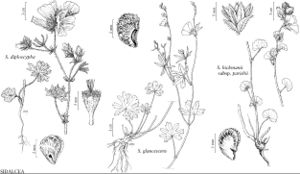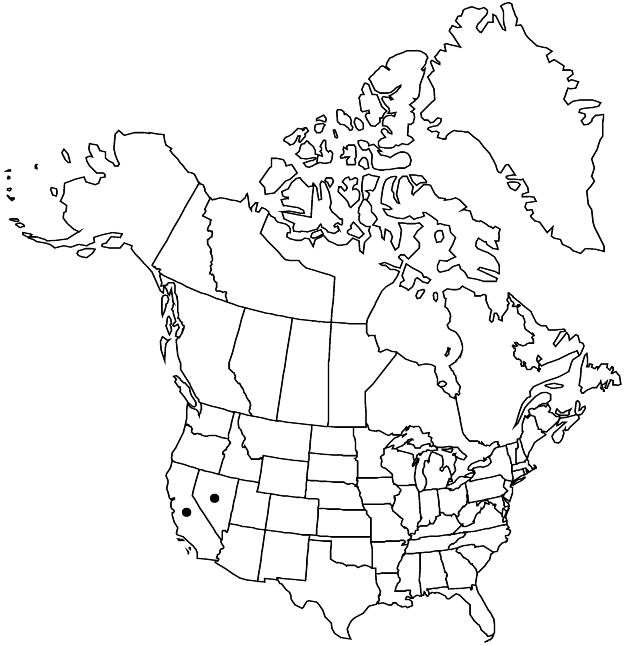Difference between revisions of "Sidalcea glaucescens"
Bull. Calif. Acad. Sci. 1: 77. 1885.
FNA>Volume Importer |
imported>Volume Importer |
||
| (6 intermediate revisions by 2 users not shown) | |||
| Line 13: | Line 13: | ||
}}{{Treatment/ID/Special_status | }}{{Treatment/ID/Special_status | ||
|code=F | |code=F | ||
| − | |label= | + | |label=Illustrated |
}} | }} | ||
|basionyms= | |basionyms= | ||
| Line 19: | Line 19: | ||
|name=Sidalcea montana | |name=Sidalcea montana | ||
|authority=Congdon | |authority=Congdon | ||
| + | |rank=species | ||
}} | }} | ||
|hierarchy=Malvaceae;Malvaceae subfam. Malvoideae;Sidalcea;Sidalcea glaucescens | |hierarchy=Malvaceae;Malvaceae subfam. Malvoideae;Sidalcea;Sidalcea glaucescens | ||
| Line 34: | Line 35: | ||
|elevation=(900–)1500–3000 m | |elevation=(900–)1500–3000 m | ||
|distribution=Calif.;Nev. | |distribution=Calif.;Nev. | ||
| − | |discussion=<p>Sidalcea glaucescens is a relatively common, generally low-growing plant of relatively high elevations; it occurs from the central and northern Sierra Nevada to the southern Cascade and Klamath ranges and to north of Reno, Nevada. It usually can be distinguished by its highly glaucous, waxy stems and leaves, 3–5-lobed, entire-margined leaves, and basal leaves that wither by the time fruit is mature; additionally, proximal flowers are spaced several centimeters apart and leafy-bracted, and the inflorescence axis is curved between flowers. It has been confused with S. asprella, S. elegans, and S. multifida, to which it appears to be closely related. It can generally be distinguished from S. multifida by its 5(–7)-lobed leaves, the lobes shallowly incised or entire, its nonpersisting, fewer basal leaves, and its more-procumbent habit. Sidalcea elegans and S. virgata in southwestern Oregon also have been confused with S. glaucescens.</p> | + | |discussion=<p><i>Sidalcea glaucescens</i> is a relatively common, generally low-growing plant of relatively high elevations; it occurs from the central and northern Sierra <i>Nevada</i> to the southern Cascade and Klamath ranges and to north of Reno, <i>Nevada</i>. It usually can be distinguished by its highly glaucous, waxy stems and leaves, 3–5-lobed, entire-margined leaves, and basal leaves that wither by the time fruit is mature; additionally, proximal flowers are spaced several centimeters apart and leafy-bracted, and the inflorescence axis is curved between flowers. It has been confused with <i>S. asprella</i>, <i>S. elegans</i>, and <i>S. multifida</i>, to which it appears to be closely related. It can generally be distinguished from <i>S. multifida</i> by its 5(–7)-lobed leaves, the lobes shallowly incised or entire, its nonpersisting, fewer basal leaves, and its more-procumbent habit. <i>Sidalcea elegans</i> and <i>S. virgata</i> in southwestern Oregon also have been confused with <i>S. glaucescens</i>.</p> |
|tables= | |tables= | ||
|references= | |references= | ||
| Line 43: | Line 44: | ||
-->{{#Taxon: | -->{{#Taxon: | ||
name=Sidalcea glaucescens | name=Sidalcea glaucescens | ||
| − | |||
|authority=Greene | |authority=Greene | ||
|rank=species | |rank=species | ||
| Line 57: | Line 57: | ||
|publication title=Bull. Calif. Acad. Sci. | |publication title=Bull. Calif. Acad. Sci. | ||
|publication year=1885 | |publication year=1885 | ||
| − | |special status=Endemic; | + | |special status=Endemic;Illustrated |
| − | |source xml=https:// | + | |source xml=https://bitbucket.org/aafc-mbb/fna-data-curation/src/2e0870ddd59836b60bcf96646a41e87ea5a5943a/coarse_grained_fna_xml/V6/V6_602.xml |
|subfamily=Malvaceae subfam. Malvoideae | |subfamily=Malvaceae subfam. Malvoideae | ||
|genus=Sidalcea | |genus=Sidalcea | ||
Latest revision as of 22:22, 5 November 2020
Herbs, perennial, 0.2–0.5(–0.7) m, glaucous, with taproot and caudex, without rhizomes. Stems usually few to many, clustered, sprawling or decumbent to ascending, rarely erect, not rooting, solid, glaucous, proximally usually stellate-puberulent, sometimes glabrous, distally glabrous. Leaves basal and cauline, basal leaves 9 or fewer or deciduous; stipules lanceolate, (2–)3–5(–6) × 0.5–1.5 mm; petioles of basal and proximal cauline leaves 6–14 cm, 3–4 times as long as blades, reduced distally to 1/2 times to as long as blades; blade reniform-orbiculate, palmately 5(–7)-lobed, deeply incised, 2–6(–8) × 2–6(–8) cm, glaucous, surfaces glabrous or minutely stellate-puberulent, lobes shallowly dentate, more deeply divided on distal leaves, margins entire, distalmost sometimes linear, unlobed. Inflorescences ascending, open, calyces not conspicuously overlapping except sometimes in bud, usually unbranched, 3–10(–20)-flowered, elongate, 1-sided, 8–20 cm, axis curved between flowers, sometimes zigzag in appearance; bracts linear to lanceolate, distinct or connate and 2-fid, 5 mm, proximal divided to base, distal often undivided, shorter than to equaling pedicels. Pedicels 2–3(–10) mm; involucellar bractlets absent. Flowers bisexual or unisexual and pistillate, plants gynodioecious; calyx 5–10 mm, enlarging in fruit, hairy, hairs scattered, minute, stellate and sometimes capitate, glandular; petals pink to pink-purple, pale-veined at least when dry, pistillate (7–)9–12 mm, bisexual 15–20(–25) mm; staminal column 4–7 mm, stellate-hairy; anthers pale yellow or pinkish to white; stigmas 6–8. Schizocarps 5–7 mm diam.; mericarps 6–8, 3–3.5 mm, roughened, sides reticulate-veined and deeply pitted, back reticulate-veined and glandular-puberulent, mucro 0.3–1 mm. Seeds 2 mm. 2n = 40.
Phenology: Flowering (May–)Jun–Aug(–Sep).
Habitat: Dry, grassy meadows, open, usually red fir, juniper, or ponderosa pine forests, often serpentine
Elevation: (900–)1500–3000 m
Discussion
Sidalcea glaucescens is a relatively common, generally low-growing plant of relatively high elevations; it occurs from the central and northern Sierra Nevada to the southern Cascade and Klamath ranges and to north of Reno, Nevada. It usually can be distinguished by its highly glaucous, waxy stems and leaves, 3–5-lobed, entire-margined leaves, and basal leaves that wither by the time fruit is mature; additionally, proximal flowers are spaced several centimeters apart and leafy-bracted, and the inflorescence axis is curved between flowers. It has been confused with S. asprella, S. elegans, and S. multifida, to which it appears to be closely related. It can generally be distinguished from S. multifida by its 5(–7)-lobed leaves, the lobes shallowly incised or entire, its nonpersisting, fewer basal leaves, and its more-procumbent habit. Sidalcea elegans and S. virgata in southwestern Oregon also have been confused with S. glaucescens.
Selected References
None.

